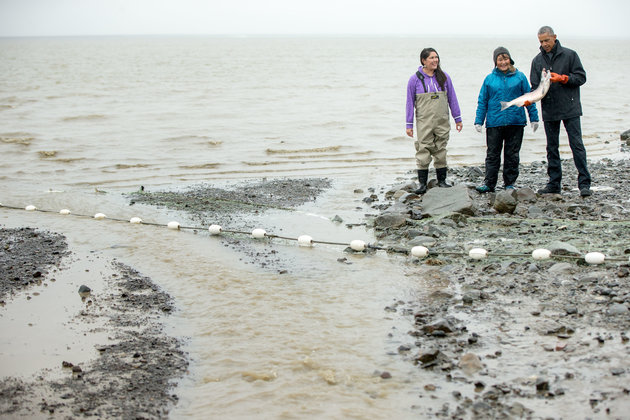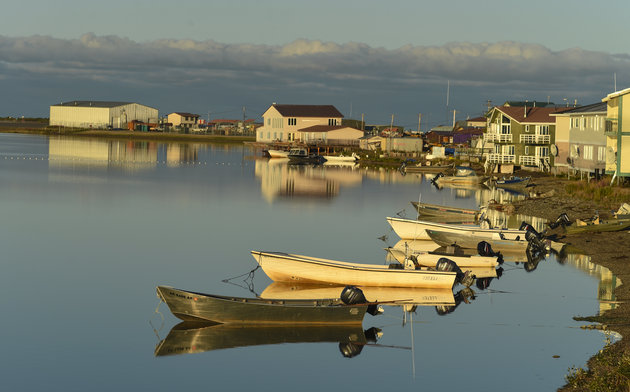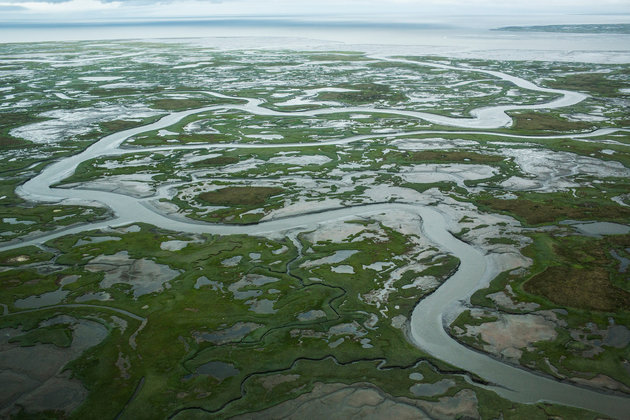The impact of climate change on Arctic communities is so great that it limits their ability to adapt, or at least that’s what has long been assumed. But according to a recent study in Nature Climate Change, it’s non-climatic factors that obstruct adaptation.

President Barack Obama holds up a fish while visiting with Commercial and Subsistence Fishers Alannah Hurley, left, and Kim Williams, second from right, on Kanakanak Beach, Wednesday, Sept. 2, 2015, in Dillingham, Alaska. Obama is on a historic three-day trip to Alaska aimed at showing solidarity with a state often overlooked by Washington, while using its glorious but changing landscape as an urgent call to action on climate change.
Arctic communities are highly vulnerable to climate change, but they can adapt, like Arviat has, according to a recent review of more than a decade’s worth of academic research looking at Arctic communities from around the world. They are adaptable because many of the people living in Arctic communities are used to experiencing change and understand their surroundings are unpredictable. “There are serious and real impacts, but communities are quite resilient in turning those changes into advantages,” said James Ford, a researcher at McGill University in Montreal, who led the study, recently published in Nature Climate Change.
But not all Arctic communities re-adjust. In their review, Ford and his colleagues found the hurdles these communities face are unrelated to climate change. Instead, outside pressures, such as outdated land management practices, bureaucratic regulatory processes, limited education and marginalization curb the ability of these communities to adapt to the effects of climate change.
For example, the Inuit in northern Canada have altered the timing and location of traditional hunting practices in response to the rapidly changing sea ice. But in some places, the regulations and quotas for hunting and fishing have not kept pace, creating a mismatch between the policy and the adaptive activity.
Ford’s study suggests changes to current policy and management models could better equip Arctic communities to deal with the impacts of climate change. But a lack of policy is also a limiting factor because adaptation hasn’t yet become part of any major policy agenda, said Ford. “You’ll see a lot of policy-makers talking and talking, but there’s very little buy-in, there’s not much leadership,” he said.
Formal meetings, conversations and even monitoring programs don’t account for the speed at which climate change-related impacts are increasingly threatening communities.
In western Alaska, for example, some communities simply don’t have enough time to collect long-term data on climate change, as Arviat is doing. Shifting infrastructure and eroding coastlines and riverbanks have attracted film crews and the media to Kivalina, Shishmaref, Newtok and other communities to capture dramatic images.

KOTZEBUE, AK – AUGUST, 31: Fishing boats in the Kotzebue lagoon on August 31, 2015 in Kotzebue, AK.
At Newtok, nearly a mile of land has slipped into the Ninglick River over the past 60 years. The village is in the midst of a relocation effort, but progress has been slow.
The community recognized the need to relocate nearly a decade ago. Construction of a $6.5 million evacuation center began in 2010, but misappropriation of funds and local corruption slowed the effort.
Misconduct is likely playing out elsewhere in the Arctic, but it hasn’t been captured in the academic literature, said Ford. “Corruption goes into the whole idea around institutional management. You have a lot of turnover in personnel and institutional memory, so there’s no long-term leadership to champion adaptation,” he said.
The Cold Climate Housing Research Center, based in Alaska, is working with Newtok’s residents to mount a more effective response as the riverbank continues to erode out from under the community. The approach is led locally and rooted in strong leadership and co-management, combined with traditional knowledge.
For now, the key players are meeting to discuss the situation, but in the future locals will play a major role in planning so that agencies can leverage funds, said Judith Grunau, a project manager and architectural designer at the center. She called the approach “holistic,” and explained that it “enables money to go further, connects everybody and allows more to be accomplished.”
According to Ford, local input directly affects how communities adapt. “Increasing community engagement has been the biggest movement in the last decade,” he said. “We’re now seeing community consultation coming in at the early stage. That’s how we need to be thinking for the future.”
Source: Huffington Post
Photo Sources: Andrew Harnik and Getty Images
Women of Green is TURNING UP THE VOLUME of the feminine voice on the planet in order to create the world we know is possible.
